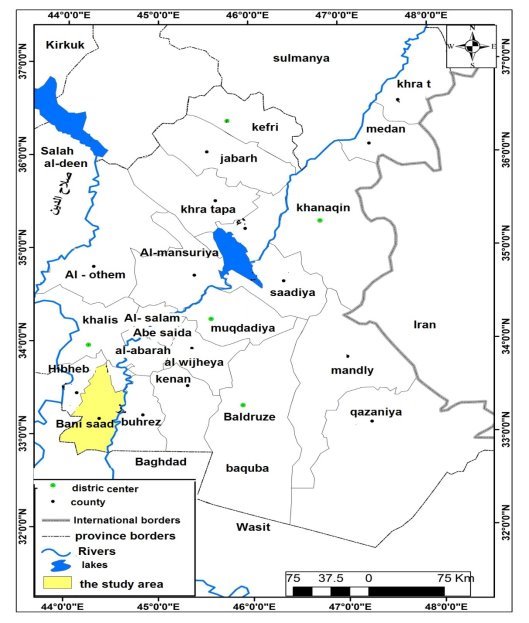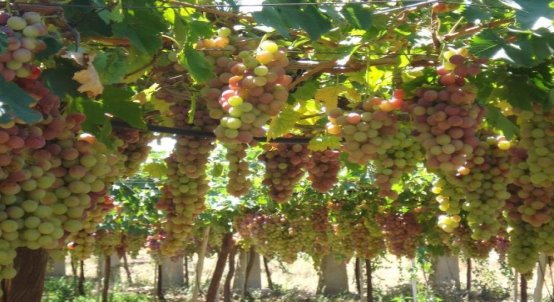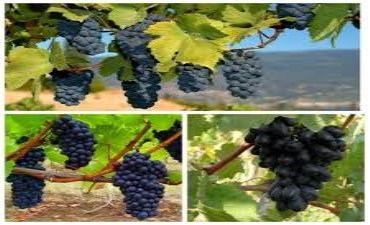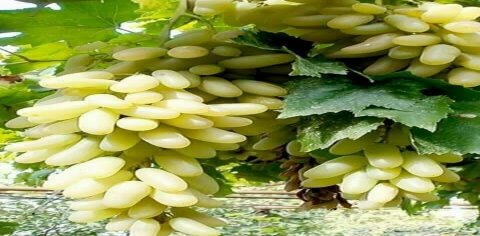Key words: region, Grapes, countryside.
Introduction:
Grape cultivation began in Central Asia in the area south of the Black Sea and the Caspian Sea, and this area was agreed by most botanists as the origin of European grapes, from which all grape varieties originated before the discovery of the continent of North America and then spread its cultivation in the East and West (1). Areas between latitudes 34–45 north and latitudes 31–38 south are the best areas for grape growing, while others assert that the origin of grapes from the Mediterranean region, as well as vineyards are known to the Sumerians at the end of the fifth millennium. BC, also found grape fossils before knowing the start of human history in Germany and Iceland (2).
The vineyards are planted with a view to obtaining abundant and good quality grape fruits for a high economic return, as grapes are a major cropgrown in the countryside of Bani Saad and constitute a proportion of its financial revenues. To achieve the highest possible return and benefit, we find that farmers in Baquba, as in the whole of Iraq, are seeking to cultivate the finest species as well as the use of land most suitable for the success of cultivation, as a result of the experience gained by farmers over time. Grape cultivation in Bani Saad area dates back to the 1980s after the reclamation of lands, which have the elements of success in terms of the presence of the Diyala River and its branches as well as fertile soil, where the abundance of these ingredients suitable for the success of the cultivation of fruit crops, including The grapes, orchards scattered on the banks of the Diyala River and its branches, is the orchards Khan Bani Saad, the main financier of local markets inside and outside the judiciary (3).
First — the problem of research
—1Is the western countryside of Bani Saad considers a grape region that meets the needs of the local market in Baquba district?
—2Are there possible for expansion of the cultivation of grapes to add other areas of this region to achieve sustainable agricultural development?
Second: the study hypothesis
1- The western countryside of Bani Saad is a region of grapes and can meet the needs of the local market in the district of Baquba.
2- There are similar lands on the Eastern strip of the countryside in Bani Saad can be planted with the crop to form a starting point for a similar regionin other areas.
Third: The aim of the study
The study aims to reveal the importance of this crop and its nutritional value and know the quantities of production to reach sustainable agricultural development and the development of other regions in the district with the same characteristics of cultivated soil.
forth: the importance of the study
The importance of research sheds light on grape development as an important and influential wealth in the countryside of Bani Saad, especially Bani Saad rural, has the ingredients the success of the cultivation of this crop and the potential contribution of the grape crop in raising farmers ' income level and contribute to bridging the local market need, so the main purpose of this Study is to take serious and practical steps by the relevant authorities, represented by the Directorate of Agriculture Diyala and Bani Saad Agriculture Division in addition to the Directorate of Water Resources in the province of Diyala, which belongs to the countryside of Bani Saad, in order to pay attention to planting grape trees and raise the efficiency and quality of production.
Fifth — Borders of the study area
The area of administrative boundaries in terms of Bani Saad, as it is bordered to the north Khalis district center and the south Hibhib and the south side is bordered by the province of Baghdad either from the eastern side Bahraz county also bordered by the city of Baquba from the north — east Map (1).
Map (1) Location of the study area
 Source: The work of the researcher based on the administrative map of Iraq, the General Authority for Survey, Baghdad 2006, on a scale scale of 1:1000000.
Source: The work of the researcher based on the administrative map of Iraq, the General Authority for Survey, Baghdad 2006, on a scale scale of 1:1000000.
The first section
Grape categories grown in the study area (4):
1- Halawani
A common high product with long branches with a length of about 15 cm long and lobed leaves, with deep cracks, large clusters, very large, fruit- filled, spherical large size close to violet with a thin crust adhered, a very firm meaty pulp with small seeds. It matures from early September to October, especially if the rain falls late. This variety is only suitable for eating and considered an expensive price. Fig. 1.

Fig. 1. Halawani
2. French:
Its branches are smaller than the Halawani as well as its clusters are slightly smaller. The fruit has a sour black color even when ripening. Of the high-yielding varieties, the ripening season begins in mid-August and marketing begins in the same month. It is a modern variant in the study area, but its cultivation has spread rapidly in all provinces of the study area. According to the farmers in the study area and specialists in the plant production department in the Directorate of Agriculture of Diyala. Fig. 2.

Fig. 2. French
3. Ajami:
It is considered a local category in the study area and is cultivated in large areas, where it is characterized by resistance to diseases. Its branches are long and the leaves are dense, so farmers resort to mitigating them (securitization) so that light can enter the heart of the trees and the clusters get enough light. It is a commercial kind in the study area, which ripens early, with maturity and marketing in mid-July.
4. White grapes are divided into two parts:
A- Dis Anz: This variety is cultivated in a small area in the study area, medium-sized clusters, fruit is long and slightly curved from the bottom end of the interior and white color and taste sweet, ripens in early September and marketed in the same month. Fig. 3.

Fig. 3. Dis Anz
B- deer horn: cultivated a few areas in the study area, medium-sized clusters pervaded and incoherent, white fruit shorter than the fruit of Des Anz, taste sweet, ripens in early September.
5. shaida
Its branches are medium in length and have two types of black and white, its clusters are small in size, the spherical fruit is smaller than the confectioner variety and close to each other, dense and abundant production, taste sweet in both black and white. It matures in July and is marketed late in August and in August.
6. Currant:
It is cultivated in small areas in the study region, its branches of medium length, small clusters of small size, the fruit is small in shape close to the spherical shape and taste very sweet and yellowish-white color. It matures in early July.
7- Al Kamali:
It is grown in most provinces of the study area, long branches, large clusters, fruit oval color near red at maturity and taste tends to acidity even after maturity, and the season of late ripening extends from the end of August until the end of September. In recent years, the cultivation area has been decreasing due to its sour taste and the wide range of sweet confectioners.
8- Albherzi:
Among the early ripening varieties, which are cultivated in limited areas in the study region, small clusters, fruit medium size oval shaped sweet taste and white color, ripening in the beginning of July.
There are other varieties not commonly grown in gardens, such as varieties of pigeons eggs, diabetes and ottoman (5).
The second section: the development of production and cultivation area by grape crop:
Grape growing in Iraq is prevalent mainly in the northern and central parts of the countryside, including the countryside of Bani Saad, where grapes have been cultivated on a large scale and for a long time, and has grown significantly during the last two decades of the last century through the introduction of new varieties and increased orchards and increased production quantities As well as regularity in the control of pests and diseases that affect the crop, we note by tracking data Table (1) that there is a clear decline in planted areas and the number of trees and the amount of production in recent years, due to human factors represented by government negligence and lack of support for farmers and competitor Imported product of the local product, and other natural and perhaps the most prominent climate with its various elements.
Table 1
Evolution of grape cultivation (area, number of trees, production and productivity(During the period (2017 2011) in the study area
|
Year |
Horticulture area / acres |
Number of trees |
Production / ton |
Average tree yield / kg |
|
2011 |
6780 |
150,000 |
3.838,5 |
3,20 |
|
2012 |
6165 |
149,3000 |
9.171,6 |
6,21 |
|
2013 |
6085 |
148,885 |
2.328,6 |
2,22 |
|
2014 |
___ |
----- |
ــــــــ |
--- |
|
2015 |
5320 |
128,360 |
7.503,5 |
8,20 |
|
2016 |
5000 |
75,655 |
2.598,4 |
6,21 |
|
2017 |
4895 |
70,000 |
4,195,8 |
20.4 |
Source: Student work based on data from Diyala Agriculture Directorate, Statistics Department, 2017.
Throughout observe database of the table No (1) which indicated the grape cultivation development in the study area during the period (2011–2018) we notice as follow:
Bani Saad county in 2011 was an area where the orchards(6780) Acres, and began to decline in the area of orchards in 2012 to reach (6165) Acres, which is equivalent to about 90,9 % of the total area in 2011, and continued decline in the area of orchards in 2013 to reach (6085 Acres), which is equivalent to about (89,7 %(of the total area in 2011, and 2015 saw a clear reduction in the area of orchards, amounted to (5320 Acres), which constitutes about (78,4 %) of the total area in 2011, and this decline continued, the area of orchards (5000 Acres), in 2016, which is equivalent to about (73,7 %) of the total area in 2011, and continued decline in the area of orchards in 2017 to reach (4895) Acres), which represents about (72,2 %) of the total area in 2011. The reasons for this decline are due to several reasons, most notably the government's negligence and lack of support for farmers, in addition to military operations witnessed by the judiciary after the occupation of the country in 2003 and to this day, where bulldozing and burning received many orchids.
Bani Saad have the number of trees grapes produced reached in 2011, (150000) trees and this number taken to decrease in the years later reaching (149,300) trees in the year 2012, which is equivalent to about (99,5 %) from among the number of trees in the year 2011,, and took the preparation trees grapes decline amounted to (148,885) trees in 2013, which is equivalent to about (99,2 %) from among the number of trees in the year 2011, and continued to decline in the number of trees reaching (128,360) trees in the year 2015, which is equivalent to about (85,5 %) of the sentence number trees in the year 2011, the number of trees fell dramatically up to (70,655) trees in 2016, which is equivalent to about (50,4 %), from among the number of trees in the year 2011, and the decline continued in the year 2017 up to (70000) trees which is equivalent to about (46,7 %) from among the number of trees in the year 2011..
The production of grapes was related to the number of trees, reaching 5838 tons in 2011, and the quantity increased to 6171 tons in 2012, an increase (3,4 %) of total production in 2011, which is directly proportional to the increase in average productivity per tree, and production continued to rise in 2013 to reach about 6328 tons, an increase(7,2 %) of the total production in the year 2011, while we find the amount of production began to decline in 2015, reaching about 5503 tons, which is equivalent to about (94,2 %) of productivity in 2011, to about 4598 tons in 2015 accounting for about (78,8 %) of production in 2011, and production continued to decline in 2017 to about 4195 tons, equivalent to (71,8 %) of production in 2011. The decrease is due to the apparent decrease in the number of trees.
There is a variation in the average yield per tree of grapes, with an average yield per tree in 2011,,(20,3 %)kg the lowest productivity level. While the highest average productivity was 2013, it was (22,2 %)kg increasing by (9 %), and then the average productivity fell back to (20,4 %) kg in 2017, which is equivalent to about (91,8 %) of the productivity of 2013.
Conclusions
− Decreasing the number of trees and areas planted with grape crops annually, which led to a decline in production, due to the impact of climatic deviations, in addition to damage and destruction caused by diseases spread in the study area by the elements of the climate, as well as the leveling of a number of orchards and other destruction because of abandoned by Owners.
− It was found through the field study that the variety of confectionery is the most common in the study area because it withstands the climatic conditions as well as the maturity period extends from the month of August to November.
References:
- Jabbar Abbas Hassan, Mohammed Abbas Salman, grape production, House of Wisdom, University of Baghdad, Ministry of Higher Education and Scientific Research, Iraq, 1989, p. 2.
- Hussein Abdullah al-Rawi, Adel Khudair Saeed al-Rawi, fruit production, Ministry of Higher Education and Scientific Research, University of Mosul, Iraq, 2000, p 13.
- Fouad Khalil Ibrahim Al-Ezzi, The Impact of Climatic Conditions on the Production of Fruit Trees in Baquba, Diyala Governorate, Iraq, «Grape and Pomegranate Trees Applied Study», Master Thesis «Unpublished», Alexandria University, Faculty of Arts, 2017, pp. 90–91.
- Fouad Khalil Ibrahim Al-Ezzi, The Impact of Climatic Conditions on the Production of Fruit Trees in Baquba, Diyala Governorate, Iraq, Grape and Pomegranate Trees «An Applied Study», Alexandria University, Faculty of Arts, 2017, pp. 91–92.







